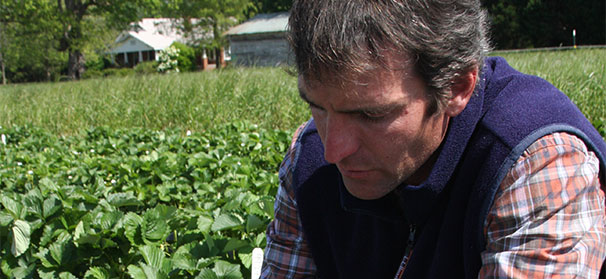

Jul 18, 2013Strawberry breeding program gets funding
To an end-game focused strawberry breeder, there is no better payoff than to see the potential for technology transfer be converted into the hands of growers to deliver a true market impact.
Jeremy Pattison, strawberry breeder and geneticist with North Carolina State University’s (NCSU) Plants for Human Health Institute, said the recent receipt of grant funds to investigate new production practices for strawberries will go a long way toward enabling growers to benefit from innovative approaches in the field.
“A lot of times the focus of research is to get published, but this one really focuses on providing training and technology transfer to growers by putting it in their hands to deliver the economic impact,” said Pattison, who recently completed a comprehensive research program that has developed a fall growing-degree day model.
Pattison has been awarded a $158,391 grant from the National Strawberry Sustainability Initiative, and is a co-investigator on a second grant led by NCSU’s Brian Whipker
.
The grants will support work in transferring the latest research to strawberry growers in North Carolina, South Carolina and Virginia, to maximize yields and profitability.
Pattison has tested the new production practices extensively at research stations across North Carolina. He looks forward to working directly in growers’ fields, because with “the challenges we have in a controlled environment, we take a lot of the real-world assumptions out of the equation.
“Whenever we go on the farm, it allows the growers’ ingenuity to sit on top of our innovations,” Pattison said. “It’s a better refined process by getting the growers involved in it.”
He said that by “relying heavily on our cooperative Extension friends, field agents and other specialists – including those at Virginia Tech and Clemson – we’re able to collaborate, divide and conquer and bring in the expertise” that allows growers to benefit.
In addition to the latest research, new technologies and tools will be shared with growers. Pattison cited a cost-effective, energy-efficient cooling system that was recently developed for use by small to medium-sized growers to increase fruit quality and reduce postharvest product loss.
Another aspect of the project will educate growers about an updated, comprehensive strawberry plasticulture farm budget that’s designed to help them better manage their financial resources.
“Small growers, in particular, need inexpensive and energy-efficient cooling systems, while all growers are looking to improve fruit quality management,” he explained. “In addition, we want to help growers mitigate financial risks by demonstrating the economic impacts of production improvements.”
The project will focus on getting crop in the ground in September and October, “depending on where we are,” and begin implementing strategies that have a high probability of success.
He said attempts will be made to moderate the large fluctuation in strawberry yields from year to year, and pursue strategies to manage the crop differently in the fall.
“How do we get varieties like Camarosa, in terms of shelf appearance and shelf life,” will be among the questions investigated, Pattison said.
“We’ve developed a strategy over about five years’ worth of work, and have a model, so we know the optimum growing degree-day requirements for Camarosa or Chandler and what to do in the fall to expect a full crop,” the researcher said.
“It really is the perfect practical project to go on farms. Those questions are best answered by growers,” he said. “We already know what the science says, what’s practical and how to hit it. We’re going to make wrong decisions, but it gives us a database of causes and effects in order to build a practical knowledge to be reactive during the October to December time period.”
Pattison said he has been meeting with growers, talking about the research and explaining “where we’ve been and where we want to go. We’re getting the buy in and getting the people signed up. Everybody is excited. With strawberries requiring such a high investment cost, (growers) are willing to take action to decrease risk because the potential for return on investment is high.”














